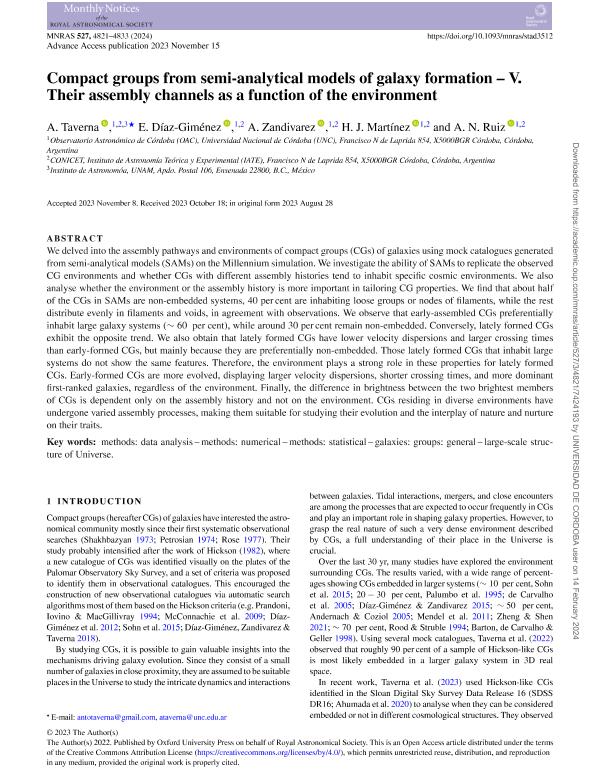Mostrar el registro sencillo del ítem
dc.contributor.author
Taverna, Maria Antonela

dc.contributor.author
Diaz, Maria Eugenia

dc.contributor.author
Zandivarez, Arnaldo Ariel

dc.contributor.author
Martinez Atencio, Hector Julian

dc.contributor.author
Ruiz, Andrés Nicolás

dc.date.available
2024-04-10T11:43:12Z
dc.date.issued
2023-11
dc.identifier.citation
Taverna, Maria Antonela; Diaz, Maria Eugenia; Zandivarez, Arnaldo Ariel; Martinez Atencio, Hector Julian; Ruiz, Andrés Nicolás; Compact groups from semi-analytical models of galaxy formation – V: Their assembly channels as a function of the environment; Oxford University Press; Monthly Notices of the Royal Astronomical Society; 527; 3; 11-2023; 4821-4833
dc.identifier.issn
0035-8711
dc.identifier.uri
http://hdl.handle.net/11336/232565
dc.description.abstract
We delved into the assembly pathways and environments of compact groups (CGs) of galaxies using mock catalogues generated from semi-analytical models (SAMs) on the Millennium simulation. We investigate the ability of SAMs to replicate the observed CG environments and whether CGs with different assembly histories tend to inhabit specific cosmic environments. We also analyse whether the environment or the assembly history is more important in tailoring CG properties. We find that about half of the CGs in SAMs are non-embedded systems, 40 per cent are inhabiting loose groups or nodes of filaments, while the rest distribute evenly in filaments and voids, in agreement with observations. We observe that early-assembled CGs preferentially inhabit large galaxy systems ( ∼60 per cent ), while around 30 per cent remain non-embedded. Conversely, lately formed CGs exhibit the opposite trend. We also obtain that lately formed CGs have lower velocity dispersions and larger crossing times than early-formed CGs, but mainly because they are preferentially non-embedded. Those lately formed CGs that inhabit large systems do not show the same features. Therefore, the environment plays a strong role in these properties for lately formed CGs. Early-formed CGs are more evolved, displaying larger velocity dispersions, shorter crossing times, and more dominant first-ranked galaxies, regardless of the environment. Finally, the difference in brightness between the two brightest members of CGs is dependent only on the assembly history and not on the environment. CGs residing in diverse environments have undergone varied assembly processes, making them suitable for studying their evolution and the interplay of nature and nurture on their traits.
dc.format
application/pdf
dc.language.iso
eng
dc.publisher
Oxford University Press

dc.rights
info:eu-repo/semantics/openAccess
dc.rights.uri
https://creativecommons.org/licenses/by-nc-sa/2.5/ar/
dc.subject
METHODS: DATA ANALUSIS
dc.subject
METHODS: NUMERICAL
dc.subject
METHODS: STATISTICAL
dc.subject
GALAXIES: GROUPS: GENERAL
dc.subject
LARGE-SCALE STRUCTURE OF UNIVERSE
dc.subject.classification
Astronomía

dc.subject.classification
Ciencias Físicas

dc.subject.classification
CIENCIAS NATURALES Y EXACTAS

dc.title
Compact groups from semi-analytical models of galaxy formation – V: Their assembly channels as a function of the environment
dc.type
info:eu-repo/semantics/article
dc.type
info:ar-repo/semantics/artículo
dc.type
info:eu-repo/semantics/publishedVersion
dc.date.updated
2024-04-09T11:47:12Z
dc.journal.volume
527
dc.journal.number
3
dc.journal.pagination
4821-4833
dc.journal.pais
Reino Unido

dc.journal.ciudad
Londres
dc.description.fil
Fil: Taverna, Maria Antonela. Universidad Nacional Autonoma de Mexico. Instituto de Astronomia; México. Consejo Nacional de Investigaciones Científicas y Técnicas. Centro Científico Tecnológico Conicet - Córdoba. Instituto de Astronomía Teórica y Experimental. Universidad Nacional de Córdoba. Observatorio Astronómico de Córdoba. Instituto de Astronomía Teórica y Experimental; Argentina
dc.description.fil
Fil: Diaz, Maria Eugenia. Consejo Nacional de Investigaciones Científicas y Técnicas. Centro Científico Tecnológico Conicet - Córdoba. Instituto de Astronomía Teórica y Experimental. Universidad Nacional de Córdoba. Observatorio Astronómico de Córdoba. Instituto de Astronomía Teórica y Experimental; Argentina
dc.description.fil
Fil: Zandivarez, Arnaldo Ariel. Consejo Nacional de Investigaciones Científicas y Técnicas. Centro Científico Tecnológico Conicet - Córdoba. Instituto de Astronomía Teórica y Experimental. Universidad Nacional de Córdoba. Observatorio Astronómico de Córdoba. Instituto de Astronomía Teórica y Experimental; Argentina
dc.description.fil
Fil: Martinez Atencio, Hector Julian. Consejo Nacional de Investigaciones Científicas y Técnicas. Centro Científico Tecnológico Conicet - Córdoba. Instituto de Astronomía Teórica y Experimental. Universidad Nacional de Córdoba. Observatorio Astronómico de Córdoba. Instituto de Astronomía Teórica y Experimental; Argentina
dc.description.fil
Fil: Ruiz, Andrés Nicolás. Consejo Nacional de Investigaciones Científicas y Técnicas. Centro Científico Tecnológico Conicet - Córdoba. Instituto de Astronomía Teórica y Experimental. Universidad Nacional de Córdoba. Observatorio Astronómico de Córdoba. Instituto de Astronomía Teórica y Experimental; Argentina
dc.journal.title
Monthly Notices of the Royal Astronomical Society

dc.relation.alternativeid
info:eu-repo/semantics/altIdentifier/url/https://academic.oup.com/mnras/article/527/3/4821/7424193
dc.relation.alternativeid
info:eu-repo/semantics/altIdentifier/doi/https://doi.org/10.1093/mnras/stad3512
Archivos asociados
